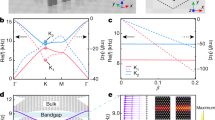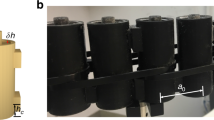Abstract
Switches and rectification devices are fundamental componentsused for controlling the flow of energy in numerous applications. Thermal1,2,3,4 and acoustic5,6,7,8 rectifiers have been proposed for use in biomedical ultrasound applications6,7, thermal computers2,9, energy- saving and -harvesting materials5,6, and direction-dependent insulating materials1,2,3. In all these systems the transition between transmission states is smooth with increasing signal amplitudes. This limits their effectiveness as switching and logic devices, and reduces their sensitivity to external conditions as sensors. Here we overcome these limitations by demonstrating a new mechanism for tunable rectification that uses bifurcations and chaos. This mechanism has a sharp transition between states, which can lead to phononic switching and sensing. We present an experimental demonstration of this mechanism, applied in a mechanical energy rectifier operating at variable sonic frequencies. The rectifier is a granular crystal, composed of a statically compressed one-dimensional array of particles in contact, containing a light mass defect near a boundary. As a result of the defect, vibrations at selected frequencies cause bifurcations and a subsequent jump to quasiperiodic and chaotic states with broadband frequency content. We use this combination of frequency filtering and asymmetrically excited bifurcations to obtain rectification ratios greater than 104. We envisage this mechanism to enable the design of advanced photonic, thermal and acoustic materials and devices.
This is a preview of subscription content, access via your institution
Access options
Subscribe to this journal
Receive 12 print issues and online access
$259.00 per year
only $21.58 per issue
Buy this article
- Purchase on Springer Link
- Instant access to full article PDF
Prices may be subject to local taxes which are calculated during checkout




Similar content being viewed by others
References
Li, B., Wang, L. & Casati, G. Thermal diode: Rectification of heat flux. Phys. Rev. Lett. 93, 184301 (2004).
Li, B. & Wang, L. Phononics gets hot. Phys. World 21, 27–29 (March, 2008).
Chang, C. W., Okawa, D., Majumdar, A. & Zettl, A. Solid-state thermal rectifier. Science 314, 1121–1124 (2006).
Kobayashi, W., Teraoka, Y. & Terasaki, I. An oxide thermal rectifier. Appl. Phys. Lett. 95, 171905 (2009).
Nesterenko, V. F., Daraio, C., Herbold, E. B. & Jin, S. Anomalous wave reflection at the interface of two strongly nonlinear granular media. Phys. Rev. Lett. 95, 158702 (2005).
Liang, B., Yuan, B. & Cheng, J. C. Acoustic diode: Rectification of acoustic energy flux in one-dimensional systems. Phys. Rev. Lett. 103, 104301 (2009).
Liang, B., Guo, X. S., Tu, J., Zhang, D. & Cheng, J. C. An acoustic rectifier. Nature Mater. 9, 989–992 (2010).
Li, X. F. et al. Tunable unidirectional sound propagation through a sonic-crystal-based acoustic diode. Phys. Rev. Lett. 106, 084301 (2011).
Wang, L. & Li, B. Thermal logic gates: Computation with phonons. Phys. Rev. Lett. 99, 177208 (2007).
Markos, P. & Soukoulis, C. M. Wave Propagation: From Electrons to Photonic Crystals and Left-handed Materials (Princeton Univ. Press, 2008).
Brillouin, L. Wave Propagation in Periodic Structures (Dover, 1953).
Sigalas, M. et al. Classical vibrational modes in phononic lattices: Theory and experiment. Z. Kristallogr. 220, 765–809 (2005).
Eichenfield, M., Chan, J., Camacho, R. M., Vahala, K. J. & Painter, O. Optomechanical crystals. Nature 462, 78–82 (2009).
Strogatz, S. H. Nonlinear Dynamics and Chaos (Perseus Publishing, 1994).
Maniadis, P., Kopidakis, G. & Aubry, S. Energy dissipation threshold and self-induced transparency in systems with discrete breathers. Physica D 216, 121–135 (2006).
Karabalin, R. B. et al. Signal amplification by sensitive control of bifurcationtopology. Phys. Rev. Lett. 106, 094102 (2011).
Vijay, R., Devoret, M. H. & Siddiqi, I. Invited review article: The Josephson bifurcation amplifier. Rev. Sci. Instrum. 80, 111101 (2009).
Campbell, D. K., Flach, S. & Kivshar, Y. S. Localizing energy through nonlinearity and discreteness. Phys. Today 57, 43–49 (January, 2004).
Soljačić, M. & Joannopoulos, J. D. Enhancement of nonlinear effects using photonic crystals. Nature Mater. 3, 211–219 (2004).
Johnson, K. L. Contact Mechanics (Cambridge Univ. Press, 1985).
Nesterenko, V. F. Dynamics of Heterogeneous Materials (Springer, 2001).
Daraio, C., Nesterenko, V. F., Herbold, E. & Jin, S. Tunability of solitary wave properties in one dimensional strongly nonlinear phononic crystals. Phys. Rev. E 73, 026610 (2006).
Coste, C., Falcon, E. & Fauve, S. Solitary waves in a chain of beads under Hertz contact. Phys. Rev. E 56, 6104–6117 (1997).
Herbold, E. B., Kim, J., Nesterenko, V. F., Wang, S. Y. & Daraio, C. Tunable frequency band-gap and pulse propagation in a strongly nonlinear diatomic chain. Acta Mech. 205, 85–103 (2009).
Hladky-Hennion, A. C. & de Billy, M. Experimental validation of band gaps and localization in a one-dimensional diatomic phononic crystal. J. Acoust. Soc. Am. 122, 2594–2600 (2007).
Boechler, N., Theocharis, G., Job, S., Kevrekidis, P. G., Porter, M. A. & Daraio, C. Discrete breathers in one-dimensional diatomic granular crystals. Phys. Rev. Lett. 104, 244302 (2010).
Job, S., Santibanez, F., Tapia, F. & Melo, F. Wave localization in strongly nonlinear Hertzian chains with mass defect. Phys. Rev. E 80, 025602 (2009).
Boechler, N., Theocharis, G., Man, Y., Kevrekidis, P. G. & Daraio, C. Defect modes in one-dimensional granular crystals. Preprint at http://arxiv.org/abs/1103.2483 (2011).
Spadoni, A. & Daraio, C. Generation and control of sound bullets with a nonlinear acoustic lens. Proc. Natl Acad. Sci. USA 107, 7230–7234 (2010).
Hong, J. Universal power-law decay of the impulse energy in granular protectors. Phys. Rev. Lett. 94, 108001 (2005).
Acknowledgements
We thank M. C. Cross, C. Hannemann, P. G. Kevrekidis, M. A. Porter, A. W. Richards and T. Schneider for useful discussions. We thank V. Gabuchian, M. Mello and S. Job for help in the experiments. We acknowledge support from the National Science Foundation grants number 844540 (CAREER), 969541 and 0520565 (MRSEC). C.D. acknowledges the Office of Naval Research (YIP), and G.T. the A.S. Onassis Public Benefit Foundation through Grant No. RZG 003/2010-2011.
Author information
Authors and Affiliations
Contributions
N.B. and G.T. developed the system concept. N.B. led the experimental work. G.T. led the theoretical and numerical analysis. C.D. provided guidance and contributed to the design and analysis throughout the project. All authors contributed to the writing and editing of the manuscript.
Corresponding author
Ethics declarations
Competing interests
The authors declare no competing financial interests.
Supplementary information
Supplementary Information
Supplementary Information (PDF 910 kb)
Rights and permissions
About this article
Cite this article
Boechler, N., Theocharis, G. & Daraio, C. Bifurcation-based acoustic switching and rectification. Nature Mater 10, 665–668 (2011). https://doi.org/10.1038/nmat3072
Received:
Accepted:
Published:
Issue Date:
DOI: https://doi.org/10.1038/nmat3072
This article is cited by
-
Design of Phononic Crystal Ring Resonator-Based Acoustic 2 × 1/4 × 1 Multiplexer and 1 × 2/1 × 4 Demultiplexer
Brazilian Journal of Physics (2024)
-
Metamaterial robot driven by nonlinear elastic waves with stop band and nonreciprocal crawling
Nonlinear Dynamics (2024)
-
Asymmetric scattering effect of solitary wave in a two-section composite granular chain
Nonlinear Dynamics (2024)
-
Total acoustic transmission in a honeycomb network empowered by compact acoustic isolator
Scientific Reports (2023)
-
Non-reciprocal acoustoelectric microwave amplifiers with net gain and low noise in continuous operation
Nature Electronics (2023)



